Manuel Antonio is one of Costa Rica’s most popular destinations, and there’s no shortage of things to do. Wildlife viewing, zip lining, and other adventure tours are must-dos for many travelers. But for something truly unique, we recommend a bee farm tour. The Manuel Antonio Bee Farm offers personalized visits to its apiary. You’ll even get to wear a traditional beekeeper outfit! In this post, we’ll share our experience visiting the Manuel Antonio Bee Farm.

Location
The Manuel Antonio Bee Farm, also known as Reserva Natural Tocori, is located in Villa Nueva. This is a small town in the countryside, about 30 minutes outside Quepos/Manuel Antonio. This area is not touristy and has an authentic feel.
Background
The idea for the apiary began with a question. A local named Miguel wondered why the bees were disappearing.
Miguel’s property is set on a hill in the thick rainforest. The large parcel remains wild and pristine, with the family home as the main structure. This is the perfect habitat for bees, which favor mature trees.
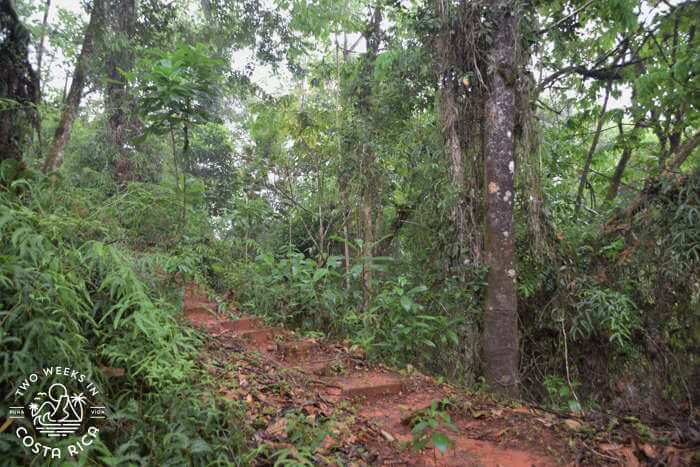
After watching the bee population dwindle around him, Miguel began to wonder if he could get the bees to come back to his property. He set out with some hives and put them in the jungle. Two years passed and nothing happened. No bees.
Miguel’s daughter then went to university to study tropical bees. Equipped with her knowledge, the two worked to attract bees and now have many thriving hives.
The Manuel Antonio Bee Farm Tour
Our tour started on the wooden porch of Miguel’s home. Over a cup of coffee and pan casero (homemade sweet bread), Miguel taught us all about bees. His passion became apparent within minutes.
History
We learned that Costa Rica once had about 200 species of bees. Then in the 1970s, African bees mixed with local bees in Brazil and created Africanized bees. These spread to Costa Rica. The queens eventually changed to Africanized bees and then laid hybrid eggs.
At the same time, Costa Rica was losing a lot of its bee habitat. Mature forest was being cut for agriculture and lumber operations.
Currently, there are only about 60 types of local bees, mostly stingless. Local bees are important because they pollinate crops and specific plants in the rainforest.
One of these stingless bees, a small brown bee called the mariola, produces special honey that is said to have medicinal purposes. Costa Ricans use this honey for its antibacterial properties. This holds true. When we lived near Dominical on the southern Pacific coast, we knew a local woman who would put a drop in each eye every day to prevent infection.
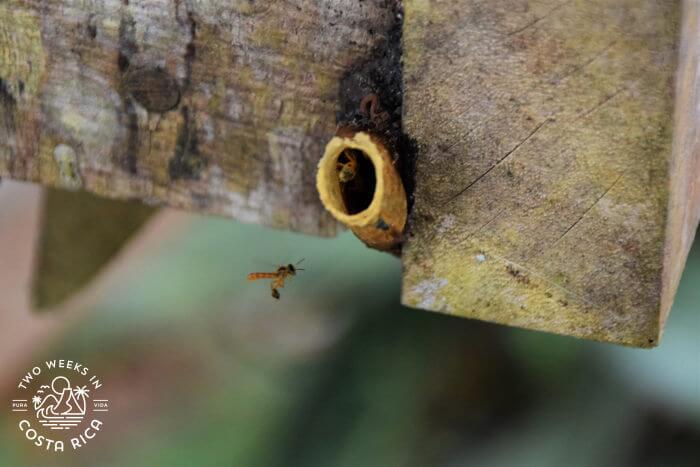
About The Hive
Pointing to some posters on the wall, Miguel then explained about the intricate hierarchy of a beehive. Inside the hive, there are three kinds of bees: drones, workers, and the queen. 99% of bees are workers.
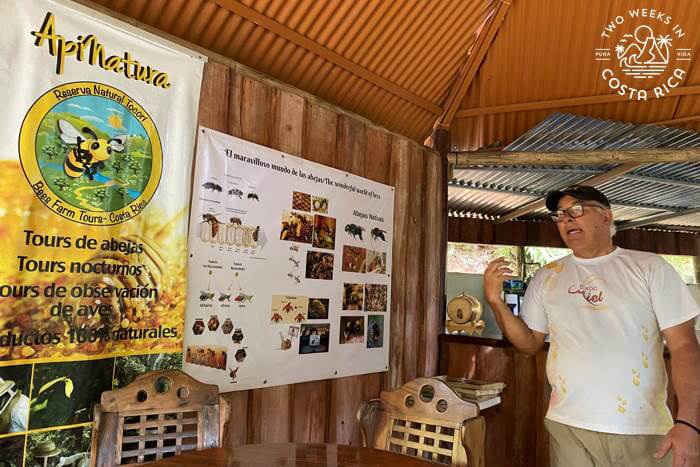
Some of the most interesting facts we learned were about the queen. The queen lays an astounding 2,000-3,000 eggs per day in the dry season (December to April). This is to increase the bee population, as the majority of bees live for only about 45 days.
Queens come from fertilized eggs. Most fertilized eggs become workers. Only if the egg is fed royal jelly will it become a queen. If more than one queen hatches at the same time, they will fight to the death to see who will be queen.
The bees have different jobs in the hive, which change as they get older. They start as cleaners and stay inside to keep things tidy so that the queen has a good place to lay eggs.
After, they are nurses and responsible for feeding the babies. Then they are builders that make wax and cells. Then, guards, and finally, foragers, that bring back nectar to make honey.
Problems
Miguel ended this first part of the tour with his insight into why the bee population was dwindling worldwide. He attributes it to pesticides and radio frequencies, which make it difficult for bees to find their way back to the hive. Deforestation is also a problem, as the bees need mature, primary forest.
With all that background, we stepped onto the muddy jungle trail to hike up to the hives.
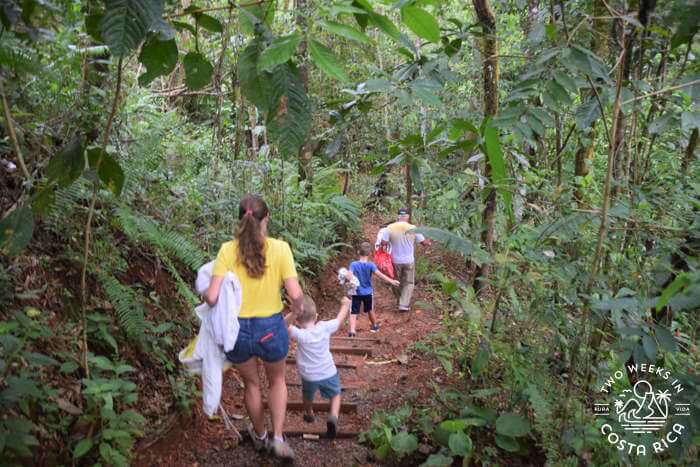
Visiting the Hives
Suiting Up
After about a 10-minute walk along the wet, slippery clay, we reached a covered area. Miguel handed us each a special suit. It was a beekeeper’s suit, complete with a mesh hat. They even had smaller kid-sized ones for our young boys. We learned that Miguel’s wife had cleverly made the suits herself.
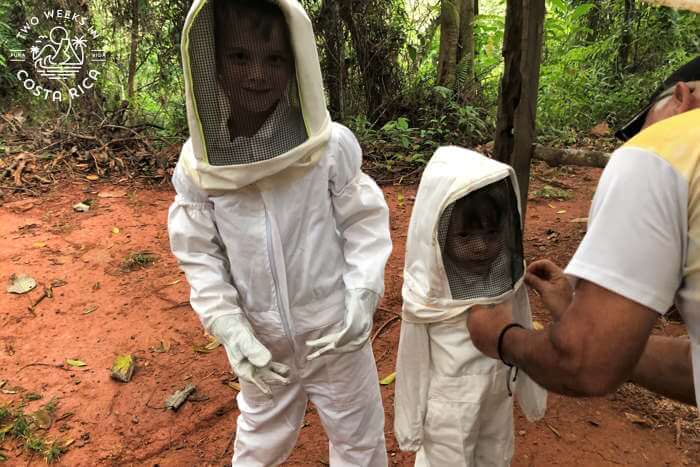
Even though it was dry season, the sky was dark, cloudy, and threatening rain. A few sprinkles began coming down, which turned into a light rain. Miguel told us that it was better to open the hives when it wasn’t raining, as the rain can make the bees aggressive.
We waited for a while until the rain lessened then climbed the hill to reach the hives.
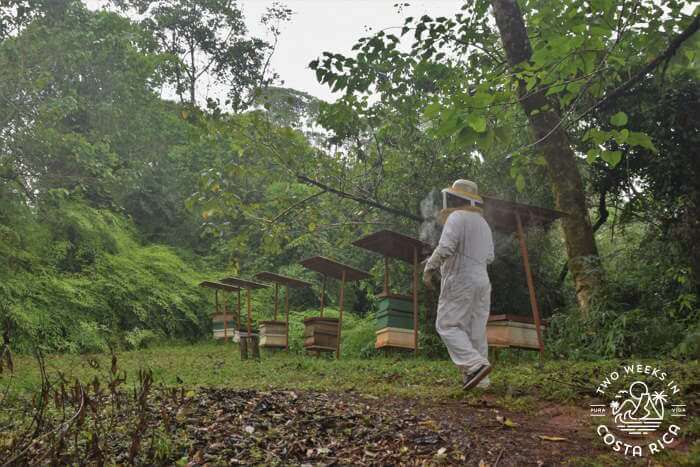
Seeing the Hives
Excited to finally get to see the bees, we watched Miguel use his smoker on the outside of a wooden hive box. After a few moments, he gently pulled out a hive. It was covered in honeybees. They were busily working on the individual cells that made up the hive.

Miguel continued to apply some smoke to keep the bees calm.
He then invited Jenn to hold the hive for a picture. With a nervous grin, she obliged. A few bees began swarming around her as the rain picked up again.

Miguel took the hive back and began pointing to the different parts that we had learned about. We even saw some delicious honey dripping.
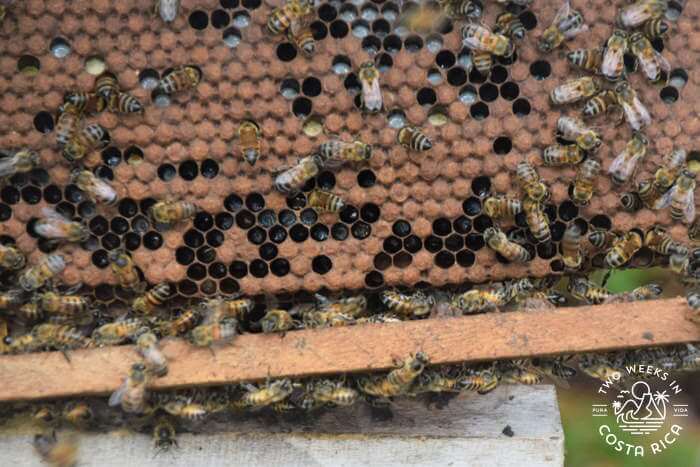
Soon after that, the bees became more agitated and started attacking Matt’s camera. Miguel had warned us that they don’t like the large SLR cameras for some reason, or cell phones. We, of course, needed some photos for our website so we went for it anyway!
With bees now swarming both Jenn (with a cell phone) and Matt (with a camera), Miguel put the beehive back and we all headed down the hill.
A few bees chased us out, but we managed to get only a few stings along the way.
Tasting the Honey
Back on the porch, Miguel invited us to try some of his rich honey. One type was from early in the season. It had a very sweet, smooth flavor. The other was from the end of the season. This one was a bit bitter and more complex.

After, we thanked Miguel and his wife for their hospitality and for teaching us about the importance and amazing life of bees.
Planning Your Visit to the Manuel Antonio Bee Farm
Cost
$50 per person adults. $30 per person children under 12.
Tour Times
Tours are offered at 9:00 a.m. This is the best time to go to avoid the rain.
What’s Included
Bilingual guide, all equipment, a traditional lunch made by Miguel’s wife, coffee, and a natural juice drink. (We did the tour at 1 pm so didn’t have lunch but it is usually included.)
What to Wear/Bring
Lightweight clothing
Hiking boots or sneakers – The jungle trail can be slick so it’s best to have good gripping shoes. Keep in mind that they may get dirty.
No perfumes, insect repellents, or strong smells as it is not good for the bees.
A change of clothes and shoes for after.
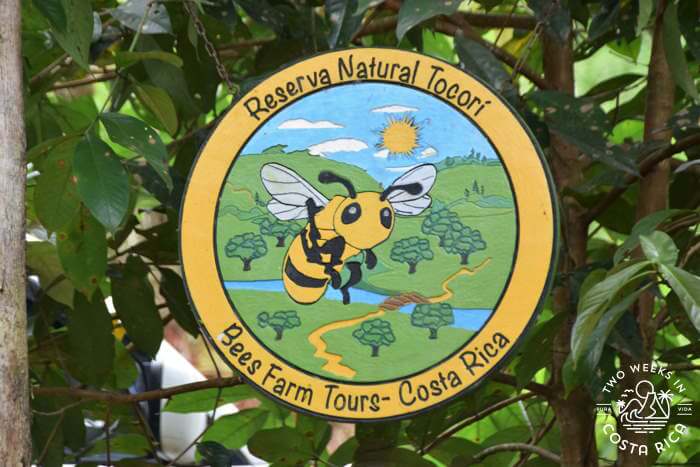
Other Tips – Preventing Stings
Make sure your beekeeper’s suit is loose fitting and covers your wrists and ankles (i.e., it isn’t too short). This is the best way to avoid stings. Miguel will give you heavy duty gloves. If you can, wear tall socks that will provide another barrier near your ankles. We got one sting on our ankles where the pants were a little too short.
Don’t bring a camera or phone with you if you’re nervous!
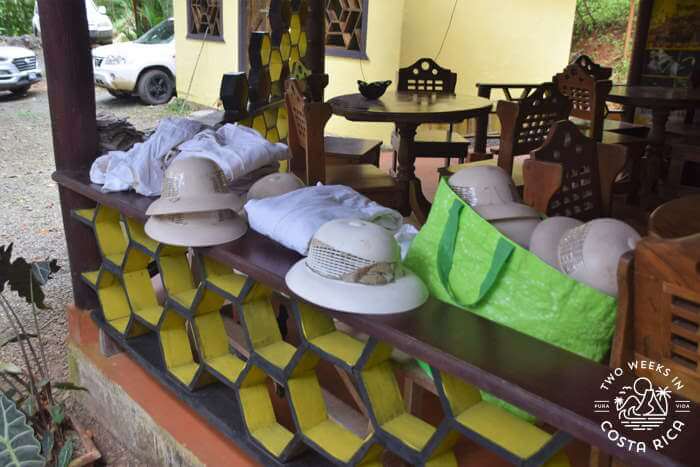
Booking a Tour
To book a tour, contact the Manuel Antonio Bee Farm directly by WhatsApp at (506) 8882-9632. You also can reach out to them via their Facebook page.
Getting to the Manuel Antonio Bee Farm
Head out of Manuel Antonio and get on Highway 34. Take the road across from the gas station Delta La Managua that heads inland. Follow the paved road through the town of Naranjito. Stay left at the fork. Take your next left. This is the road for the bee farm. There will be a sign. Go down and then up the hill. The farm will be on the right. The last part of the drive is not paved but fine with a regular sedan (no 4×4 needed).
GPS coordinates: 9°29’04.3″N 84°04’58.6″W
Google Map with GPS coordinates: https://goo.gl/maps/YAqAJgAPZCj7PX5S7
When you book the tour, the bee farm will send you the map location.
*Note that as of this writing (February 2023), the location on Google Maps was not correct if you search for the bee farm.
Conclusion
Being able to visit an apiary in Costa Rica was unlike anything we’ve done before. Seeing the bees in the hive, with a deeper appreciation for their complexity and importance, was something we’ll always remember.
Have a question about visiting the Manuel Antonio Bee Farm? Ask us below.
Looking for more information about visiting the Manuel Antonio area? Check out these posts:
Villa Vanilla Spice Farm: This is another wonderful tour in the Manuel Antonio area. Villa Vanilla is a working farm that grows vanilla, cinnamon, and other spices.
7 Off-the-Beaten-Path Things to Do Near Manuel Antonio: Learn about other lesser known activities in the area. Includes a hike with hanging bridges and an authentic chocolate tour.
Costa Rica Rental Car Discount: To get to activities like this, you’ll need a rental car. Check out our discount through one of Costa Rica’s most reputable companies.

Love this and seem to love all your articles. Thank you for the seemingly tireless effort you put in to endlessly keep us aware of all the wonder of Costa Rica.
You’re welcome, Laura! Thank you for your kind comment.
Loved the article. What an interesting tour. Do they sell any honey?
Hi Linda, Glad you liked the article 🙂 Yes, they do the sell the honey.
Hi! I tried to reach out via whatsapp and the number says it is not being used on whatsapp currently! Should I email them instead?
Hi Kaitlyn, We just checked the number and it’s working on WhatsApp. Make sure you’re putting them in your phone correctly. You’ll need to add +1 before the 506 if you’re not in Costa Rica. If it still doesn’t work, you could send them a message on Facebook. It looks like their Facebook page also connects to WhatsApp if that is easier.
We will be staying at the Karahe Beach Hotel in Manuel Antonio. We will not be using a rental car to get around, only shuttle service or city bus.
If we should decide to purchase this tour, which rental car service do you recommend? Also,
Hi Joan, You could rent a car for the day only. The company that we recommend, Adobe Rent a Car, has a location in Quepos (next to Manuel Antonio) and could deliver the car to your hotel for free. Just specify your hotel as the pickup location when you make the reservation. Here’s the link to our rental car page to check pricing and availability.